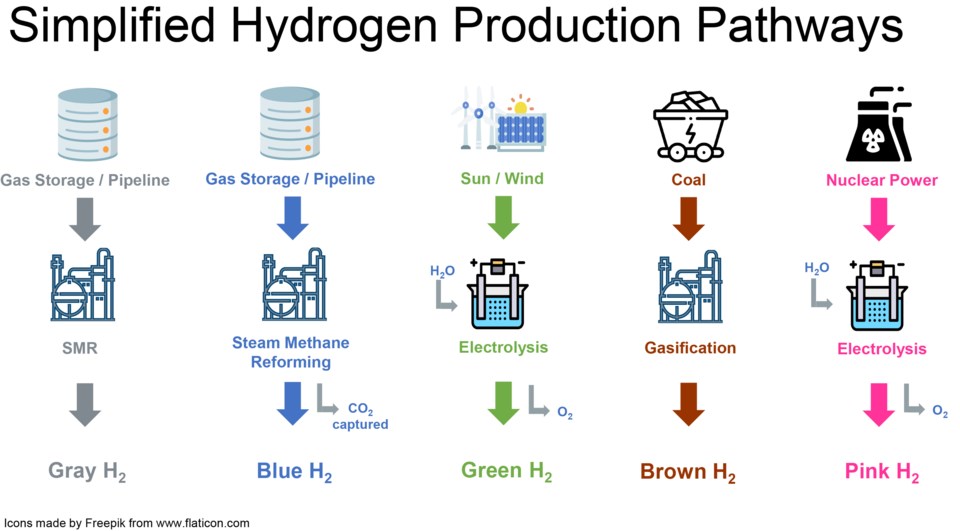Great West Media has received federal government funding through the Local Journalism Initiative to support a reporter to cover climate in Alberta.
Jen Henderson will feature in-depth reporting on where Alberta is at with actions to reduce carbon emissions and generation of less carbon-intensive energy, along with climate issues across the province as they intersect with industry, business, the environment, the economy, communities, and lifestyles.
Please email [email protected] with story ideas.
As countries around the world transition to clean energy, Alberta is banking big on hydrogen to help facilitate the province's green transition.
In November 2021, Alberta released its Hydrogen Road Map to prepare for a lower-emission future, which outlined how Alberta is well positioned to become a global supplier of clean, low-cost hydrogen.
Amit Kumar, professor at the University of Alberta and Alberta Innovates associate industrial research chair in energy and environmental systems engineering, said the province is well positioned with cheap natural gas, a trained workforce, the Alberta Carbon Trunk Line, and a leading jurisdiction in carbon capture, utilization, and storage (CCUS)
“There are a few things which align well with hydrogen, especially for Alberta. We have been doing it for decades, so we have a lot of expertise in producing hydrogen,” Kumar said.
What is hydrogen?
Hydrogen is a gas that is predominantly produced from natural gas through a method called steam methane reforming (SMR) and most of the hydrogen produced in the province right now is created through that method, Kumar said.
Hydrogen is used to produce synthetic crude oil in the oil and gas industry, said Kumar, and is also used to produce fertilizers and ammonia.
Most of the hydrogen in the province is produced from natural gas and the process emits C02, which is currently released into the atmosphere, Kumar said, noting the hydrogen produced through this process is known as grey hydrogen.
But what the province is trying to do is capture the C02 emitted from the process, to drastically reduce emissions, thereby creating blue hydrogen.
There are other ways to make hydrogen, said Kumar, such as through renewable energy (green hydrogen), nuclear energy (pink hydrogen), or coal (brown hydrogen), but the province primarily makes hydrogen through natural gas.
Currently, very little CCUS is being used in the province, and most hydrogen created is done through the grey hydrogen creation process, which emits a lot of C02, Kumar said, but once the carbon capture systems are set up, the hydrogen produced will have extremely low emissions.
Through the SMR process to create hydrogen, the industry can capture anywhere from 52 per cent of the C02 up to 90 to 95 per cent of the emissions, including those created from the process to capture and store the carbon.
Once the hydrogen is created, it can be used as an alternative energy source in many industries, Kumar said, and when it is used as a fuel it only emits water.
The province hopes to use hydrogen in vehicles, and to generate electricity power and heat.
But the biggest opportunity for hydrogen in the future will be to ship it to other countries that are trying to use green energy and are interested in using hydrogen as an alternative energy source.
“We are a net energy exporting jurisdiction,” Kumar said. “If you think about other jurisdictions, they are talking about hydrogen and they want to transition their economy to hydrogen, a much ... cleaner economy.”
But even through the province wants to export hydrogen in the future, there is very little hydrogen currently being used globally as power, Kumar said. Although not much is being exported right now, the province aims to be exporting a million tonnes of hydrogen by 2030.
To use hydrogen to heat homes, it must be blended at 20 per cent with natural gas, and if any more hydrogen is added, the appliances in a home would have to be replaced to be able to use the hydrogen.
“We're talking about the industrial sector, where they use it to process heat and other purposes where natural gas is used."
To use the hydrogen to fuel cars, new cars must be developed and sold, and fuelling stations must be built across the province, Kumar said.
The expert said he believes the province has good support to build a hydrogen economy and is in a much stronger position than other provinces.
“I think the province is trying to grow this economy and is a leader in this.”




